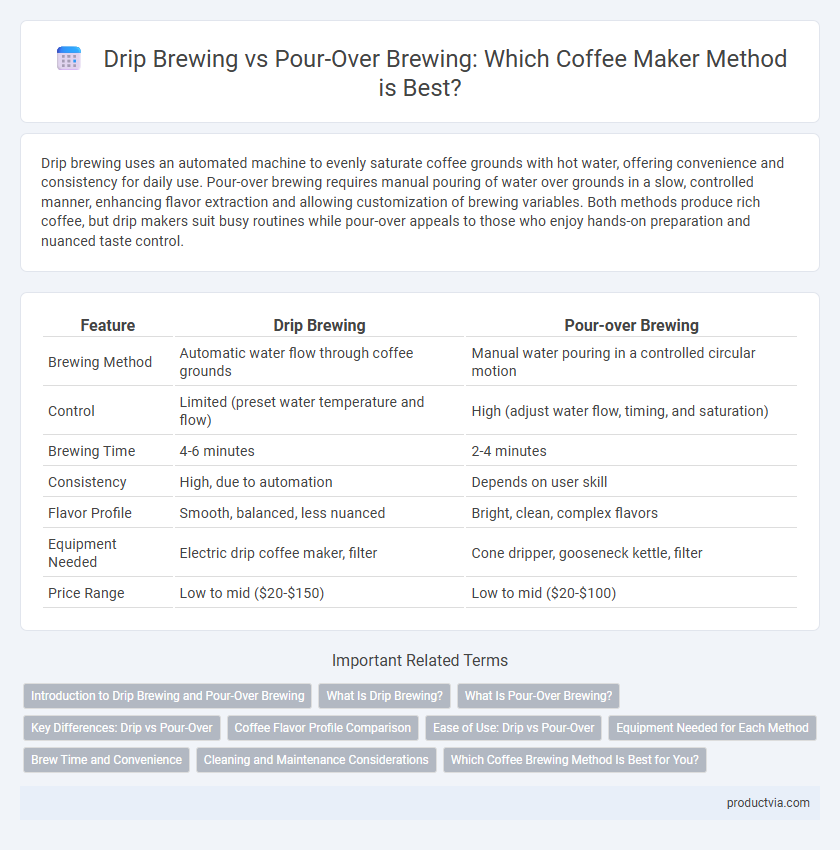Drip brewing uses an automated machine to evenly saturate coffee grounds with hot water, offering convenience and consistency for daily use. Pour-over brewing requires manual pouring of water over grounds in a slow, controlled manner, enhancing flavor extraction and allowing customization of brewing variables. Both methods produce rich coffee, but drip makers suit busy routines while pour-over appeals to those who enjoy hands-on preparation and nuanced taste control.
Table of Comparison
| Feature | Drip Brewing | Pour-over Brewing |
|---|---|---|
| Brewing Method | Automatic water flow through coffee grounds | Manual water pouring in a controlled circular motion |
| Control | Limited (preset water temperature and flow) | High (adjust water flow, timing, and saturation) |
| Brewing Time | 4-6 minutes | 2-4 minutes |
| Consistency | High, due to automation | Depends on user skill |
| Flavor Profile | Smooth, balanced, less nuanced | Bright, clean, complex flavors |
| Equipment Needed | Electric drip coffee maker, filter | Cone dripper, gooseneck kettle, filter |
| Price Range | Low to mid ($20-$150) | Low to mid ($20-$100) |
Introduction to Drip Brewing and Pour-Over Brewing
Drip brewing involves an automated coffee maker that evenly saturates coffee grounds with water, producing a consistent and convenient cup of coffee. Pour-over brewing requires manual pouring of hot water over coffee grounds in a filter, allowing precise control over extraction time and flavor profile. Both methods utilize hot water to extract coffee solubles but differ in automation, control, and brewing time, influencing taste and aroma characteristics.
What Is Drip Brewing?
Drip brewing is an automated coffee brewing method where hot water is evenly sprayed over ground coffee beans in a filter, allowing the brewed coffee to drip directly into a carafe or pot. This technique ensures consistent extraction and is commonly used in electric drip coffee makers for convenience and speed. The controlled water flow and temperature in drip brewing result in a balanced flavor profile, making it ideal for brewing multiple cups efficiently.
What Is Pour-Over Brewing?
Pour-over brewing is a manual coffee-making technique where hot water is slowly poured over coffee grounds in a filter, allowing precise control over brewing time and temperature. This method enhances the extraction of coffee flavors, resulting in a clean, bright, and aromatic cup. Unlike drip brewing, pour-over brewing requires a steady hand and attention but offers superior customization for coffee enthusiasts.
Key Differences: Drip vs Pour-Over
Drip brewing uses an automated coffee maker that evenly distributes hot water over ground coffee for consistent extraction and convenience, while pour-over brewing requires manually pouring hot water in a circular motion for precise control over brew time and water flow. Drip machines typically offer programmable settings and capacity for multiple cups, whereas pour-over brewing is more suited for single servings with customizable flavor profiles. The key difference lies in automation and consistency with drip systems versus the hands-on, artisanal approach of pour-over methods.
Coffee Flavor Profile Comparison
Drip brewing produces a consistent and balanced coffee flavor with medium body and mild acidity, ideal for those who prefer a smooth and straightforward cup. Pour-over brewing highlights the coffee's bright and complex flavor notes with higher clarity and vibrant acidity, emphasizing unique origin characteristics. The precision in pour-over technique allows for greater control over extraction, resulting in a more nuanced and aromatic coffee profile compared to automatic drip machines.
Ease of Use: Drip vs Pour-Over
Drip brewing offers superior ease of use with automated processes and programmed settings, making it ideal for busy mornings or users seeking convenience. Pour-over brewing requires manual control over water flow and timing, demanding more skill and attention for optimal extraction. Coffee makers featuring drip brewing technology streamline preparation, while pour-over setups cater to enthusiasts who prefer hands-on customization.
Equipment Needed for Each Method
Drip brewing requires an electric coffee maker equipped with a water reservoir, heating element, and a built-in filter basket, allowing for automated water flow and timing. Pour-over brewing relies on manual equipment, including a cone-shaped dripper, paper filters, and a kettle with a gooseneck spout to control water flow precisely. While drip machines offer convenience with programmable settings, pour-over setups provide greater control over extraction variables, emphasizing the importance of quality kettles and filters for optimal flavor.
Brew Time and Convenience
Drip brewing offers faster brew times, typically completing a full pot within 5 to 10 minutes, making it ideal for convenience and large batches. Pour-over brewing requires more precision and manual effort, with brew times ranging from 2 to 4 minutes per cup, emphasizing control over extraction. While drip machines excel in automated ease and quantity, pour-over methods provide a customizable experience for coffee enthusiasts.
Cleaning and Maintenance Considerations
Drip coffee makers feature automatic cleaning cycles and removable parts that simplify maintenance, while pour-over brewing requires manual cleaning of filters and carafes after each use, demanding more frequent attention. The reusable filters in drip machines reduce waste but need regular descaling to prevent mineral buildup, whereas pour-over equipment allows for easier access and thorough scrubbing of individual components. Choosing between these methods depends on ease of cleaning preferences and time dedicated to maintaining optimal coffee flavor and hygiene.
Which Coffee Brewing Method Is Best for You?
Drip brewing offers convenience and consistency, making it ideal for those who prefer a hands-off approach with larger batch sizes. Pour-over brewing provides greater control over extraction, resulting in a richer, more nuanced flavor favored by coffee enthusiasts. Choosing between drip and pour-over depends on your desired balance of convenience, control, and flavor complexity.
Drip brewing vs Pour-over brewing for coffee makers Infographic

 productvia.com
productvia.com